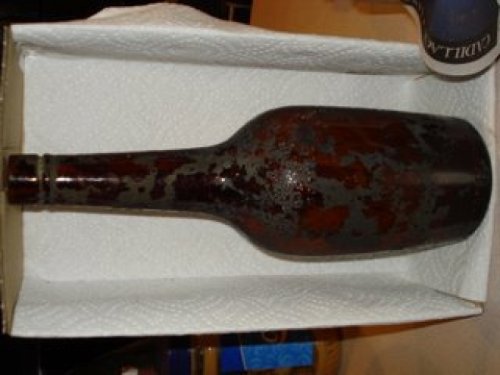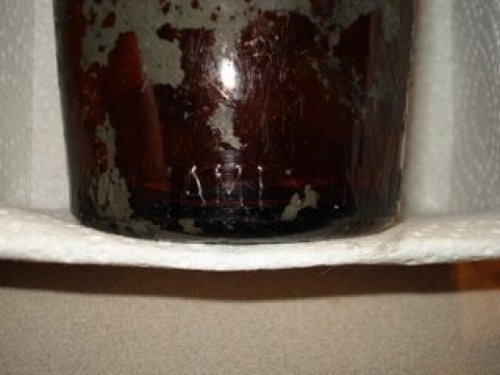You are using an out of date browser. It may not display this or other websites correctly.
You should upgrade or use an alternative browser.
You should upgrade or use an alternative browser.
wm jameson & co.
- Thread starter danny
- Start date
surfaceone
Well-Known Member
- Joined
- Dec 9, 2008
- Messages
- 11,161
- Reaction score
- 23
- Points
- 0
Hey Danny,
This is a more modern one with the "Federal Law" embossing putting it in the 1934-1962 era. Man, you've been diggin & divin it up.
This is a more modern one with the "Federal Law" embossing putting it in the 1934-1962 era. Man, you've been diggin & divin it up.
surfaceone
Well-Known Member
- Joined
- Dec 9, 2008
- Messages
- 11,161
- Reaction score
- 23
- Points
- 0



"Marrowbone Lane (William Jameson & Co.) – Dublin
1752 – c. 1923
The Marrowbone Lane distillery is another one of those Irish distilleries which has more or less completely disappeared, both physically and from the memory of people in Ireland. Amazing really, when you consider that at its height it was the second largest distillery in Dublin, extending to an incredible 13 acres and producing 900,000 gallons of whiskey annually and especially considering it carried the famous Jameson name.
The early years of the distillery, as for many others, are rather vague. Barnard was told that in 1779 the ancestors of the firm had purchased a small distillery making less than 30,000 gallons annually. The family connection to the more famous John Jameson of Bow Street Distillery goes back to John Stein, who had owned both distilleries around 1780. John Jameson married into the Stein family and by 1802 the Marrowbone Lane Distillery was listed under the name of Jameson and Stein, but William Jameson’s exact relationship to John Jameson is unclear.
As the reputation and demand for the product grew, so did the distillery. Around 1880 the proprietors invested £100,000 (about Euro 1 million in today’s money) in a massive expansion project which saw the installation of two mash tuns, the largest in the United Kingdom (100,000 gallons each) and 13 fermenting vessels, some of which could hold 100,000 gallons. They were so large Barnard said they could have held a two storied villa, with a garden path round it inside them. The Distillery had four pot stills, ranging in size from 9,000 to 18,000 gallons and nine bonded warehouses, which contained 21,000 casks at the time of Barnard’s visit. The company also had four “out†warehouses, located in the immediate vicinity of the shipping port and the goods terminus of railways entering Dublin, which held another 7,000 casks. The Cooperage took up nearly one acre and employed 30 men and the Engine Department had four different engines. There were 5 chimney stacks, the tallest being 110 feet, and a complete fire-extinguishing system. As with all distilleries of this period, it was self sufficient, with Carpenters’, Painters’, Engineers’ and Smithy Shops, all on site. The Stables were the size of a cavalry barrack, with their own horse hospital and 14 lofts capable of containing 12 months’ feed. The whiskey was known as Dublin Whiskey and was pure pot still. It was mostly exported to the Commonwealth and the U.S.A., which maybe explains why so few Dubliners remember this brand name.
In 1891, the company joined forces with the nearby George Roe Distillery and the DWD Company in Jones’ Road to form the Dublin Distillers Company Ltd. Their combined distilling capacity amounted to 3.5 million gallons, but unfortunately it was exactly the wrong economic time to have such massive capacity and stocks. By the early 20th century, cheaper Scottish blended whiskies were seriously eroding Ireland’s traditional export markets. The Irish war of independence, followed by trade war with Great Britain, in the same time period as American prohibition, nearly killed off the Irish whiskey industry. The William Jameson Distillery succumbed and closed around 1923 (though it may have been as late as 1926). The distillery was completely demolished – probably in the period 1930-1950 – to make way mostly for municipal housing. The bonded warehouses would have been the last to go, with the last stocks being sold, during, or just after World War II.
Barnard in 1886, described the distillery as being in the suburbs of Dublin, close to the beautiful Grand Canal, with overhanging trees extending over a mile into a background of foliage and hills. Anyone familiar with this part of Dublin today would be dumbfounded by this description. This area of Dublin is now one of the least attractive parts of the inner city and that mile of the Grand Canal is infilled and grassed over. Absolutely nothing notable remains of this once great distillery. Our research found only one old wall in which pigeons were nesting, just off Marrowbone Lane – with its telltale iron girders still visible, most probably one of the grain stores.
The whiskey fared no better. We know of no bottles of William Jameson whiskey in any old pubs in Ireland, nor any old mirrors. Bottles have turned up infrequenty at collectors' auctions (see photo) – it is interesting to note that a sticker refers to the whiskey being aged in the Irish Free State, indicating that it was bottled more than likely after the distillery closed. Most of the stocks would appear to have been disposed of in the U.S.A. A brand by the name of William Jameson Irish American Whiskey was advertised in the 1930's - with the description 'Irish for bouquet, American for flavor and made up of 25% pot still whiskey aged 20 years by WM Jameson & Co of Dublin Ireland and 75% straight whiskey 12 month old specially distilled by National Distillers Louisville Kentucky'. All that beautiful 20 years old pot still Irish whiskey ending up in such a way - doesn't bear thinking about really.
William Jameson Marrowbone Lane Distillery - Marrowbone Lane, Dublin 8
If you have any information, photos or know of any old bottles from the William Jameson Distillery in Dublin, we'd love to hear from you, so please don't hesitate to contact us.
Further reading:
The Whisky Distilleries of the United Kingdom by Alfred Barnard" From The Ireland Whiskey Trail.
Similar threads
- Replies
- 6
- Views
- 1K
- Replies
- 2
- Views
- 452
- Replies
- 1
- Views
- 538
- Replies
- 2
- Views
- 634
- Replies
- 13
- Views
- 2K
Latest threads
-
-
-
-
Wood bottle model-Clear Springs Pop Shop, Vancouver B.C.
- Started by Canadacan
- Replies: 2
-
Beginner Question - Price Guide?
- Started by indianainsulators
- Replies: 3
-
Wanted: Quick City Glass Works
- Started by indianainsulators
- Replies: 0




